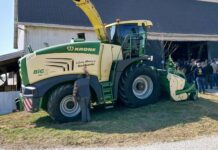SALEM, Ohio – Investigators continue to search for the source of the nation’s first case of mad cow disease.
Tissue from a Holstein cow from a dairy farm near Mabton, Wash., tested positive during Christmas week for bovine spongiform encephalopathy (BSE), or mad cow disease.
The sample was taken Dec. 9. The USDA’s National Veterinary Services Laboratories in Iowa, which tested and retested the sample, released the finding Dec. 23.
A sample was immediately sent to the BSE world reference lab in England, which confirmed the finding Dec. 25.
The farm, about 40 miles southeast of Yakima, Wash., is quarantined.
U.S. Secretary of Agriculture Ann Veneman said the incident is not terrorist related.
Canadian connection. The USDA investigation suggests the animal entered the United States in a group of 74 dairy cattle imported from Alberta, Canada, in 2001.
The other cattle in that shipment are being tracked down, although the USDA said there is nothing to suggest any of the other animals were infected with BSE.
The group went to a dairy finishing facility, also in Washington. From there, the cow moved to the now-quarantined herd in October 2001.
There is a discrepancy as to the cow’s age. The Washington herd owner’s records lists the animal between 4 and 4 1/2 years. Canadian records say she was born in April 1997 and had two calves already in Canada.
DNA testing will determine the correct age.
In a news conference Dec. 23, ag secretary Veneman said it was too early to tell if there was any connection between this cow and Canada’s isolated BSE incident confirmed last May in a beef herd.
Canadian officials have contacted the owner of that herd in Alberta, Canada, but as of Saturday, the USDA could not make a connection between the Washington and Canadian incidents.
Birth herd unknown. “We do not have a definitive diagnosis or confirmation of the individual animal and/or of its birthplace,” said Brian Evans, chief veterinary officer with the Canadian Food Inspection Agency.
A small, silver ear tag suggests the tag is of Canadian origin, but officials were trying to verify that as of Sunday.
The birth herd is the most likely location where the infection took place, officials say. The incubation period is an average of four to five years, so the cow would have had to be infected early in her life.
Birthing complications. The cow had recently given birth to a bull calf, resulting in complications that led to her being culled.
The calf was sold to a farm in Sunnyside, Wash. It was not tagged, so all bull calves at that farm under 30 days old are likely to be depopulated.
The cow had previously had two calves. One died at birth shortly after the cow’s purchased by the Washington farm. The second, a yearling heifer, is in that herd under state quarantine.
Food safety. After the downer cow was slaughtered Dec. 9, infectious materials were removed and sent to rendering, a standard practice on downer animals tested by USDA. Muscle cuts of the meat were sent to Midway Meats for processing Dec. 11.
Midway sent boneless beef products from the carcasses to Interstate Meat Distributors and Willamette Valley Meat, both in Oregon, Dec. 12.
Interstate Meats ground all of the products into ground beef or ground beef patties.
Byproducts seized. The USDA has seized all potentially rendered byproducts from the affected cow.
All central nervous system tissue went to inedible rendering, according to Ken Petersen with the USDA Food Safety Inspection Service.
The USDA is working with the renderers to voluntarily recall the products.
Risk to animal feed. “Our major concern is that these products do not get back into cattle feed,” said Stephen Sundlof of the FDA’s Center for Veterinary medicine.
“If that were to happen, then we could have a true expansion or amplification within the U.S. cattle herds.”
As little as a half a gram of raw infected brain fed to cattle, particularly calves, can result in the disease in those cattle fed the infected brain, Sundlof said.
Most material, however, would go through a rendering process, which reduces the infectious nature of that material by a factor of at least 10.
Sundlof said cattle are much more susceptible to the disease than humans.
Verns Moses Lake Meats, a Moses Lake, Wash., company voluntarily recalled a little more than 10,000 pounds of raw beef Dec. 23.
The company said the beef may have been exposed to tissues containing the infectious agent that causes BSE.
The recall is considered a Class II recall, which identifies only a “remote” possibility of adverse health consequence.
“There is virtually no chance that the meat has been contaminated,” Veneman said. She stressed the finding “does not pose any kind of significant risk to the human food chain.”
Limited product recall has been made of products in Oregon, Washington, Nevada, California, Alaska, Montana, Hawaii and Idaho, as well as the territory of Guam.
Milk and milk products from cows are not believed to pose any risk for transmitting the BSE agent, according to the Centers for Disease Control in Atlanta.
Imports banned. Several countries quickly closed their borders to U.S. beef imports following the news last week.
The reaction came even though the plant where the Holstein cow was slaughtered was not a participant in the beef export verification program, meaning it does not export beef.
Japan, the second largest market for U.S. beef exports by volume and the largest by value, imposed an indefinite ban on U.S. beef.
Joining suit were South Korea, Russia, Thailand and Hong Kong, among others.
According to the U.S. Meat Export Federation, 13.4 percent of U.S. beef production is exported. In 2002, the United States exported $1.03 billion worth of beef, veal and prepared beef products to Japan.
Can it spread? U.S. ag secretary Veneman stressed the disease does not spread easily. “This is not foot-and-mouth disease,” she emphasized.
It is not believed that mad cow disease spreads by animal-to-animal transmission. The disease spreads only by consumption of affected proteins or proteins of an infected animal.
The quarantine of the host farm is simply designed to stop movement of animals on and off the farm, officials said.
“The most likely means of spread of the disease is by an animal consuming protein that came from an animal that is infected with the disease,” said Ron DeHaven, chief veterinary officer for the USDA.
The FDA outlawed feeding ruminant-derived meat and bonemeal supplements to cattle in 1997.
DeHaven said there is some speculation that there may be transmission from cow to calf. International standards suggest that any offspring born to an infected cow should be sacrificed and not go into the food chain, which is why the bull calf and other offspring are being identified and slaughtered.
He said the rates of multiple infections within a single herd are rare. “Very often, just one animal within a herd is found to be infected,” DeHaven said.
Surveillance program. This is the first case detected since the United States initiated a mad cow surveillance program in 1990.
The case was found in a federally inspected plant. All U.S. cattle are inspected by a USDA inspector or veterinarian before going to slaughter. Animals with any signs of neurological disorder are tested for BSE.
In the past 12 months, more than 20,500 head of cattle were tested for BSE.
Tracking animals. The case renews debate over a national animal identification program.
Following last week’s announcement, John Meyer, CEO of Holstein Association USA, said an identification program would further safeguard the nation’s food supply.
“This case accentuates the importance of the National FAIR animal identification program to quickly and effectively track animal movements from birth, farm to farm, and eventually to slaughter.”
Get the details
* Regularly recorded updates are available by calling toll-free: 1-866-4USDA-COM
* Food safety questions can be answred at the USDA’s hotline: 1-888-MPHotline (674-685463)
USDA updates
www.usda.gov/
Animal and Plant Health Inspection Service
www.aphis.usda.gov/lpa/issues/bse/bse.html
FDA
www.fda.gov/oc/opacom/hottopics/bse.html
Centers for Disease Control
www.cdc.gov/ncidod/diseases/cjd/cjd.htm
Farm Sanctuary
www.nodowners.org
The Humane Society of the United States
www.hsus.org
Further information
www.bseinfo.org
USDA’s October ruling to allow live animal imports from Canada
www.usda.gov/news/releases/2003/10/0372.htm
Get 4 Weeks of Farm and Dairy Home Delivered









